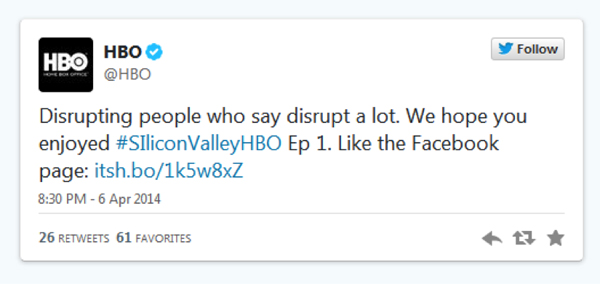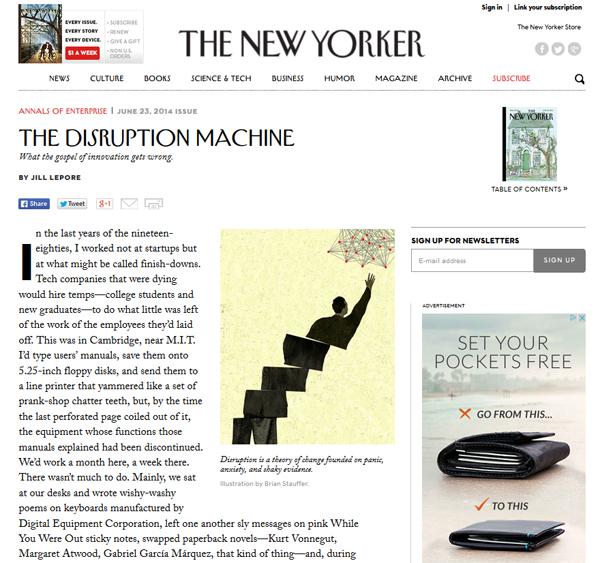Despite recent debate to the contrary, disruptive innovation is alive and well in our industry
Earlier this summer, several articles emerged in the popular press that took hard looks at the conventional thinking in the business world about disruptive innovation and the validity of the well-established theory of a regular procession of industry leaders being overtaken by upstarts, in almost formulaic fashion. First, the New Yorker’s Jill Lepore penned, “The Disruption Machine: What the Gospel of Innovation Gets Wrong,” and the New York Times followed a few days later with an op-ed response by Anna North, “Arguing About the Truth of Disruption,” referencing Lepore’s article and others. (Through the magic of Internet publishing, the New York Times piece has a June 18 publication date, compared to the New Yorker article’s June 23 issue date.)
This “disruption talk” was part of the language and a key theme throughout the first-season run of one of my new favorite TV serials, HBO’s Silicon Valley. The show was wrapping up at about the same time as the appearance of the aforementioned press activity about disruptive innovation, and in its satirical but hilarious take on the world of startups, the fictional-but-based-on-reality entrepreneurs closed their season exhibiting at no less than the very real “Disrupt” conference which takes place in San Francisco and is sponsored by TechCrunch. (Note: I wasn’t the only fan of the show—it was recently acknowledged with a handful of Emmy nominations, as well as a renewal for its second season.)

This screenshot of a tweet from HBO is one example of how Silicon Valley played on the buzzword disrupt.
Aside from the pop culture connection, I found it fascinating from an academic perspective, seeing such a “business basic” so vigorously challenged, with the coverage drawing in some of my non-business friends from the broader audience of New York Times and New Yorker readers. The debate centers on the long-term validity of the theory most prominently advanced by Harvard Business School professor and author Clayton Christensen, beginning with his groundbreaking book The Innovator’s Dilemma. Lepore in particular made the case that the anecdotal accounts just don’t add up to a consistent outcome, with in some cases at least the anecdotal outcomes twisted a bit to fit the formula rather than vice versa. The debate, to me, is reminiscent of the challenge presented by Freakonomics author Steven Levitt who took on Jim Collins’s Good to Great findings, which in the added perspective of several more years of history made the top companies seem rather ordinary—or worse (see “From Good to Great … to Below Average”).

The theory of disruptive innovation was started or at least renewed via The Innovator’s Dilemma and leads to continued theorizing as this Google Images search shows.
I regularly use Christensen’s ideas in my marketing and economic university teaching and feel a kinship to the theory based on my crossing paths (though never meeting) Professor Christensen way back during my disk drive days at HP, which for me date back to 1981–1986 and for him, a similar span, and which led up to his doctoral dissertation in 1993. On the economics side, Lepore also points out a much earlier proponent of related disruption school of thinking, that being economist Joseph Schumpeter and his “creative destruction” theories of the first half of the twentieth century. So these discussions add additional dimension to my teaching, as well.
Without further summarizing the New Yorker article*—with the exception of the quote in the following paragraph—I turn attention to another angle prominent on my personal radar screen, going beyond my pop culture and higher education angles. What about applications in my “day job” where I cover the printing and imaging business as a writer/analyst?
I can certainly see some examples from our industry in one of Lepore’s nicely summarized descriptions from the latter part of “The Disruption Machine”:
The logic of disruptive innovation is the logic of the startup: establish a team of innovators, set a whiteboard under a blue sky, and never ask them to make a profit, because there needs to be a wall of separation between the people whose job is to come up with the best, smartest, and most creative and important ideas and the people whose job is to make money by selling stuff.
With this description, Memjet immediately comes to mind—a geographically isolated R&D unit, thinking about printing with different mindsets and challenging the status quo. The transference from R&D to the group responsible for commercialization, as Lepore mentions in the final part of the paragraph, remains an uncertain challenge in this case.
Another case is third-party supplies and the entrenched printer OEMs with their own branded, higher-priced supplies. With alternative suppliers offering quality approaching that of the original, much more aggressive pricing, and innovations in areas like distribution channels, we can certainly make the case for active disruptive innovation constantly churning up the supplies side of the business.
And in the case of an internal “skunk works,” in the words of another business guru, Tom Peters, one need look no further than industry leader HP. With a credo something along the lines of “disruption is inevitable so better we disrupt ourselves,” disruptive innovation has come from its “Ink in the Office” and now “Ink in the Enterprise” initiatives (see “HP’s Groundbreaking Officejet Pro X Units Start Shipping” and “HP Takes Aim at Large Businesses with New Officejet Enterprise X Series”). With these devices, HP has improved performance and print quality in what were formerly thought by many to be “home printers,” to the point where at long last inkjet printers and MFPs can take on office laser printers and MFPs, including, of course, HP’s own LaserJet devices.
Overall, with some more thought and effort, we can envision more, even broader examples of the Schumpeter/Christensen theories at work in imaging and printing. The creeping presence of ever-more-adept mobile devices is certainly a disruptive force for the imaging and printing industry, and some would argue that the spread of smartphones and tablets undermines the very need to print. But that is another blog post!
*I recommend a full read of Lepore’s very well-researched work available at http://www.newyorker.com/magazine/2014/06/23/the-disruption-machine.
Jim Lyons has been writing, analyzing, and blogging about industry developments since 2006, after leaving a long-term stint as a marketing and program manager in HP’s Imaging and Printing Group. In his monthly Observations column, he comments on business and marketing developments in the printing and imaging industry, combining many years of experience with an ever-enthusiastic eye on the future. Lyons is also a faculty member at the University of Phoenix, teaching marketing and economics at its school of business, and is a regular contributor to both The Imaging Channel and Workflow. Follow him on Twitter @jflyons and read more Observations from Jim Lyons at http://www.jimlyonsobservations.com/.








1 Comment
Jim – Great read!
GMTA – ‘Turbulence’ not Disruption…
http://www.waltersshutwell.com/2014/07/its-not-disruption-its-turbulence.html#.U9JqPVYRW-U